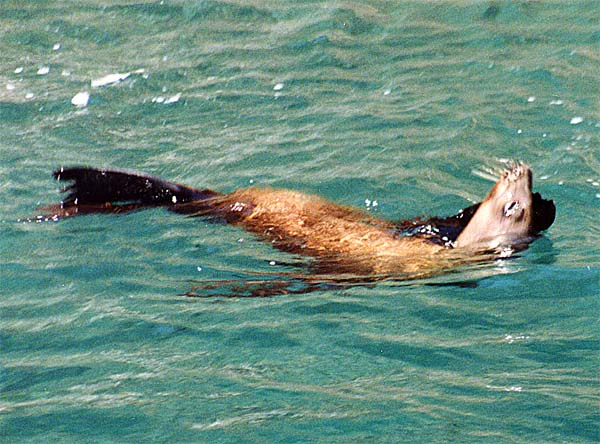


A California Sea Lion is swimming in the ocean near the California coast. California Sea Lions are found all along the California coast. They have been seen as far north as British Columbia in Canada, and as far south as the southern tip of the Baja peninsula in Mexico and in Mexico's Gulf of California.
California Sea Lions are mammals. They breathe at the surface and hold their breath while diving. They have been known to dive as deep as 800 feet! California Sea Lions are powerful swimmers. They can swim at 25 miles per hour for short distances, and can leap from the water as they swim. Male Sea Lions are called bulls. Large bulls can be up to 8 feet long and can weigh as much as 800 pounds. Female Sea Lions can be up to 6.5 feet long and can weigh as much as 400 pounds. Sea Lions eat fish, shellfish, octopus, and squid. Sea Lions lounge on the beaches and rocky coasts when they are not swimming, to sleep in the sun safe from the Orcas and Great White Sharks that hunt them. They hold themselves up with their flippers to help them move about on land. In the water, they paddle with their front flippers and steer with their tail flippers.
California Sea Lions breed in the southern part of their range. The Channel Islands (near Santa Barbara, California) are an important breeding site, but Sea Lions sometimes breed as far north as Año Nuevo Island (in Santa Cruz county, California). Their breeding grounds extend as far south as the San Benito Islands of Mexico's Baja Peninsula. Sea Lions gather in large groups called rookeries on the sandy shores of remote islands to breed. Rookeries may have as many as 1000 California Sea Lions. Baby Sea Lions are called pups. Female Sea Lions can have babies when they are 3 years old. Male Sea Lions remain bachelors until they are at least 5 years old.
Wild Sea Lions can live as long as 18 years. They face many natural dangers, including Orcas, Great White Sharks, disease, and parasites. But humans also can harm Sea Lions by their actions. Sea Lions may be trapped by fishing nets, poisoned by pollution, and even killed by getting tangled in the plastic rings that hold together six packs of soda-pop cans. (Be sure to cut apart these fasteners to break the rings before you throw them away. This will prevent entangling all kinds of animals, no matter where you live.) California Sea Lions are protected by the Marine Mammal Protection Act of 1972. It is unlawful to feed, touch, or harass these animals.
Diana Reischel took this photograph. Diana is a marine biologist. She helped rescue sick and injured California Sea Lions when she worked for the Marine Mammal Center in Sausalito, California. Visit the Marine Mammal Center to learn more about California Sea Lions and other marine mammals.